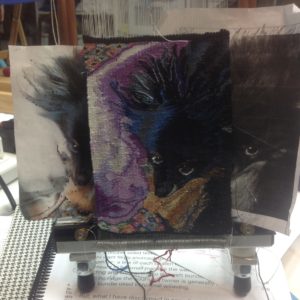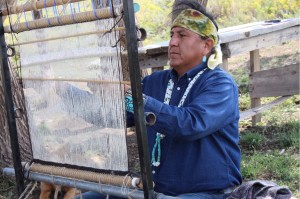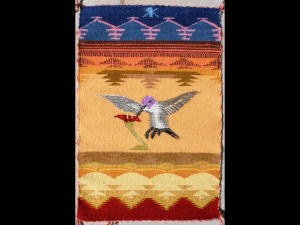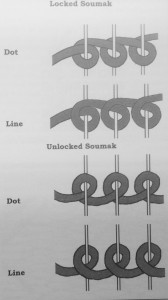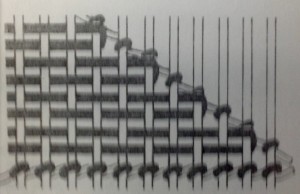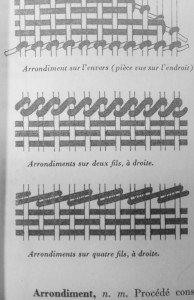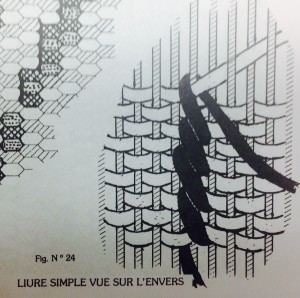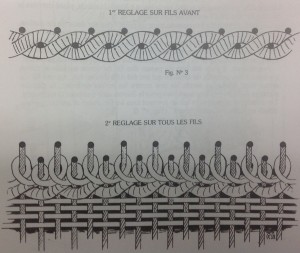Blogging for luddites who just happen to be tapestry weavers
One of the hardest things I find for me to do is learn how to use new computer technology and programs. First, I am dyslexic, secondly, I 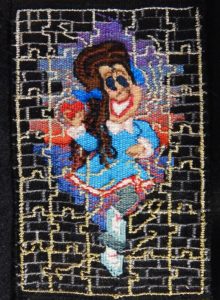 don’t like change, third, I am a luddite in every sense of the word. fourth, fifth, if it isn’t broke don’t fix it and why do I need the latest bells and whistles, sixth, a morbid fear of not having enuff time to weave, Seventh a paralyzing fear of getting started and a willingness to procrastinate so I don’t have to deal with it all, New technology and change scare me to the point of paralysis.
don’t like change, third, I am a luddite in every sense of the word. fourth, fifth, if it isn’t broke don’t fix it and why do I need the latest bells and whistles, sixth, a morbid fear of not having enuff time to weave, Seventh a paralyzing fear of getting started and a willingness to procrastinate so I don’t have to deal with it all, New technology and change scare me to the point of paralysis.
Remember that I work in a medium that has not changed much in a thousand or more years.
AND, I am just now revisiting images that I drew as a child.
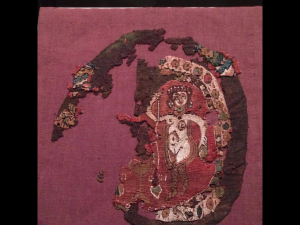
coptic rondel—- while computer programs make radical changes in the blink or less of an eye. . AND, I am comfortable with that supposed “flaw.” Okay there are exceptions to that rule of change. Well, perhaps, the looms have…
So, Whenever, I get a new journal I need to scar up it’s pristine condition a bit do get started. So, this is scarring the blog and making 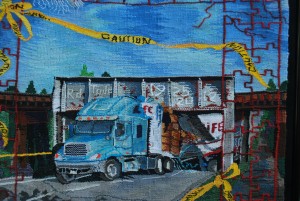 it not so pristine-making it no longer perfect, but more doable…for the next blog entry. Because, It no longer matters if I continue to mess it up.-gr! I will have been there and done that.
it not so pristine-making it no longer perfect, but more doable…for the next blog entry. Because, It no longer matters if I continue to mess it up.-gr! I will have been there and done that.
- Since I last wrote-I have traveled to almost everycorner of the US for teaching, visiting, traveling to The ATA Small Format exhibit in Louisiana.(now in Dover, Delaware at the Biggs Museum of American Art) I have had a one person exhibit at ETC in Eugene, Or. (I have another coming up in January at LBCC called Past Narratives-Tapestries by Kathe Todd-Hooker), attended Sheep is Life in Tsalie, NM and visited with friends, students, workshops, taught at several conferences, visited with family in places like DC
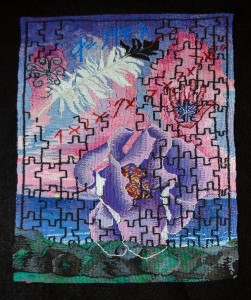 and Montana, NM, L, and teaching all along the way-along. A true Itinerent weaver in every sense of the word. But, now it’s time to hunker down and get some serious work done.
and Montana, NM, L, and teaching all along the way-along. A true Itinerent weaver in every sense of the word. But, now it’s time to hunker down and get some serious work done. - Titelbaum Award winner-In the ATA small format exhibit.
I am beginning to create new tapestry products to sale that feel a need. These new tools are being fabricated even as I write. The first new tool is a facsimile of a wonderful Persian Tapestry/rug beater that isn’t available in the US. Besides the weighted forkbeater this is my new favourite beater-since the Shannock beaters are so hard to acquire-notice I said beater not comb which is a subject for a future blog. The beater will be available through my classes and through Between & Etc formerly known as Fine Fiber Press. it will cost 80.00. Orphan tools are extremely exspensive to produce, but this beater is well worth the cost.
Another one of the exciting things is I am now teaching classes in my studio. I will also have guest instructors teaching in my studio.
I taught two back to back classes in August and will be teaching 3 or 4 more in the next 9 months. Watch for the schedule.
Roy Cady will be teaching in the studio in February.
The real subject of this blog is about some discoveries and AHA’s that I made on these trips and teaching in my studio this summer.
I have been writing for my new book Tapestry, Soumack and Friends and discovered that there were things/issues/holes/etc. I needed to address. So I am. I am really wanting this book to be a comprehensive study of these techniques and reflect my years of research and doing them!
Anyway, while working with Roy Cady and his apprentices at Tsalie 
and with my students in my studio, I realized that I had never written anything about double sided textiles and weaving from the back using these techniques. The questions that I needed to answer were how do you make the soumack lines appear on the back and the front simultaneously? Is soumack always an appropriate technique for lines that need to be seen on the front or back, or on both sides? In the end it created a need for me to do a bunch of or mass of re-writing and more samples for the book.
So to begin. It sounds easy, but it is complicated by the various styles of weaving-front, back double-sided, texture or not of the soumack, architectural or vertical soumack, whether it floats on the surface or is actually archtectual-part of the fell line.
To simplify, If you use line soumack on the front of the weaving- the back side of the weaving will always be dots or if you want dots on surface the soumack line will be on the back. (see diagram from Tapestry 101)The biggest problem with this is the dots disappear into the weaving as passes
cover them unless there is a greater thickness of the twiner. So does one want the added texture or is the texture what you need for the design? If you are weaving from the front you see what the finished line will look like as you weave.
If you weave from the back the surface of the tapestry will be the back
and you are not actually seeing what the line-your seeing dots-not what the line will look like on the finished tapestry-unless you use a mirror or can turn the loom around which is a slow tedious interupting process. It has been done in past and it is called which is called arrondiment in French Gobelin style weaving.
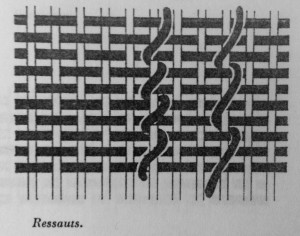
ressaut-dot soumack on that would appear as dots on the front of a tapestry woven from the back side
Above diagram-This is another form ressaut that would put the line on the front of the tapestry being woven from the back. I t can be woven or wrapped directionally
On the newer smaller looms especially if the warp is two layered or wrapped around the loom there is barely enough space to have the mirror between the warps and actually see the whole weaving with an unobstructed view. BUT, with a mirror inserted between the two layers of warp it is possible to see the area that you are weaving and if the line is doing what you want it to do.
Mirror tiles work great or if you have one of the smaller looms you can purchase mirrors of the right width or even have them cut to size. CAUTIONARY ADVISE from a klutz- tape the edges of the mirror unless it is
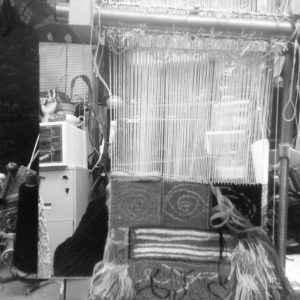
placing a mirror tile between the back and front warps on a mirrix.The mirror is hanging out on the left of the loom with a reflection of my arm and the back of the studio as I try and get a photography.
framed. Also, tape a wide cross across the back of the mirror tile-just in case!!!! for those some of us with an inner clutz problem.
- For double sided textile where both sides are meant to be seen. If you want to do soumack- use line soumack and dot soumack together- a line of each beaten together to form one line. If the line is meant to be small manage the weft bundles in such away by adding and
 subtracting to the weft bundles size. If I want a flat surface with no ridge the soumack twiner is generally half the size of the weft bundle used in normal weaving.
subtracting to the weft bundles size. If I want a flat surface with no ridge the soumack twiner is generally half the size of the weft bundle used in normal weaving.
But, what I have discovered in sampling is there may be a better solution to producing smooth lines on double sided textiles-twining. But, of course, twining can also be done from either side and in some cases produces smoother curves when twined vertically. In some ways twining creates a smoother curve when doing circles and spirals. It doesn’t have the problem of being left handed or right handed that soumack has-created by the direction you turn around the controlling warp. But one needs to remember that twining is controled
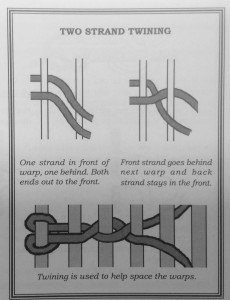
Twining on the flat, but twining can also float up anad over passes just like soumack and can be worked from the middle and both directions out .
by the between spaces not the warp. It is also slightly easier to snag, but can be easily readjusted to the proper spacing and texture. The biggest disadvantage is that it is difficult to make sharp corners look sharp if your doing squares or anything that needs to mount at a sharp angle. Twining is also not generally used in gobelin style or Aubusson
weaving. I did fine an odd variation in the Galice use at Savonerie of both what appears to be twining and soumack used in a diagram,
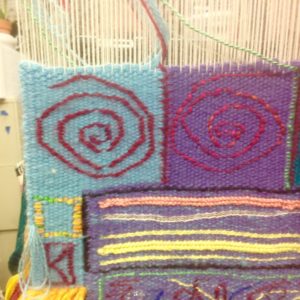
lite turquoise spiral is soumack-line on the front
purple square is a spiral done in twining-which is double side, yellow box is rya done so pile is on the opposite side and yellow rya done for the front surface
So I have been revisiting my Gobelin techniques and the two books that are so of the modern bibles of Gobelin weaving-Roland Galices-La Technique de A a…X…de la Tapisserie de haute lisse et du tapis de Savonnnerie and my Principe d’analyse scientifique Tapisserie-methode et vocabulaire which was gifted to me by one of my old
instructors who found the book in Romania at a used book store. So the techniques are woven from the back and are called Ressaut and Arrondiment. Roughly translated by me to mean architectural soumacks, vertical soumack, and a stuffed or core 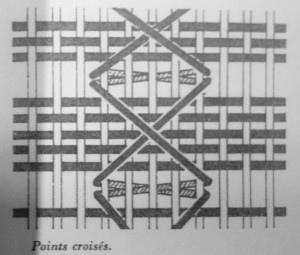 wrapped soumack.
wrapped soumack.
The stuffed and wrapped soumacks are just now becoming extremely popular, but have been done in Gobelin weaving for centuries. It again needs to be reversed when working from the front, but is doable on both the front and the back.
Enuff for now. Watch for a blog on Roy Cady and the class he’ll be teaching in my studio in February along with a calendar of classes being taught in my studio.
Cheers and all,
kathe
Post Script-Hope I caught all of the spelling errors-still trying to figure out the spellcheck and my new dyslexic alphabet is still in process.
